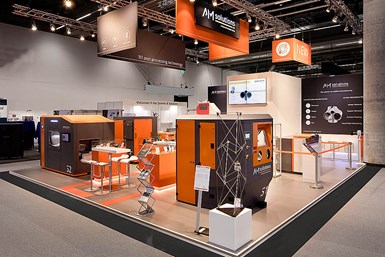AM Solutions’ Postprocessing Systems for Additively Manufactured Parts
Formnext 2022: AM Solutions offers postprocessing technologies for a full range of AM-produced materials.
AM Solutions’ additive manufacturing technology includes a range of postprocessing operations for plastic, metal and resin AM parts.Photo Credit: AM Solutions
AM Solutions’ (a brand of the Rösler Group) additive manufacturing (AM) technology includes a range of postprocessing operations for plastic, metal and resin AM parts.
The company’s M1 Basic is a compact entry-level system well suited for the surface smoothing and polishing of metal or plastic AM parts. The S1 is a 2-in-1 solution for cleaning and surface finishing of polymer parts produced in AM powder bed systems.
It is said the S1 Wet is a versatile wet blast solution designed for cleaning and surface finishing of metal AM parts. The S2 is works for the uniform cleaning, surface homogenization and/or peening in continuous mode operation of plastic parts produced in AM powder bed systems.
T and the C1 are said to provide fully automatic support and resin removal from photopolymer parts. In addition, the company’s C2 is a 2-in-1 system currently in development for the chemical surface smoothing of and dye application to plastic AM parts.
“We are able to provide various postprocessing technologies for the full range of AM produced materials. Some of our technologies are specific to resin, plastic or metal AM parts, but some have the ability to postprocess both metal and plastic parts, providing not just amazingly accurate and repeatable postprocessing, but also cost-effective postprocessing,” says Daniel Hund, head of marketing at Rösler/AM Solutions. “AM is not only an agile and innovative manufacturing process with the ability to produce parts impossible using traditional manufacturing processes, but it also has the ability to democratize and localize manufacturing to promote digital inventory, and to have a substantial and positive environmental benefit.”
With the continued growth in AM as a production technology (not simply a prototyping technology), there can be greater scrutiny on the validation of surface finish, conformance with design intent and the attainment of exacting tolerances repeatably. AM parts and components can exhibit extraordinary geometric and internal channel complexity, which may add problems when it comes to postprocessing. The technology also uniquely requires support removal when using certain build technologies and materials or powder removal, all of which may add to the postprocessing.
Related Content
-
Copper, New Metal Printing Processes, Upgrades Based on Software and More from Formnext 2023: AM Radio #46
Formnext 2023 showed that additive manufacturing may be maturing, but it is certainly not stagnant. In this episode, we dive into observations around technology enhancements, new processes and materials, robots, sustainability and more trends from the show.
-
FDA-Approved Spine Implant Made with PEEK: The Cool Parts Show #63
Curiteva now manufactures these cervical spine implants using an unusual 3D printing method: fused strand deposition. Learn how the process works and why it’s a good pairing with PEEK in this episode of The Cool Parts Show.
-
Airless Basketball Shows Promise of 3D Printed Lattices: The Cool Parts Show Bonus
Successfully matching the performance of a standard basketball demonstrates the control possible over the mechanical properties of digital materials.
















